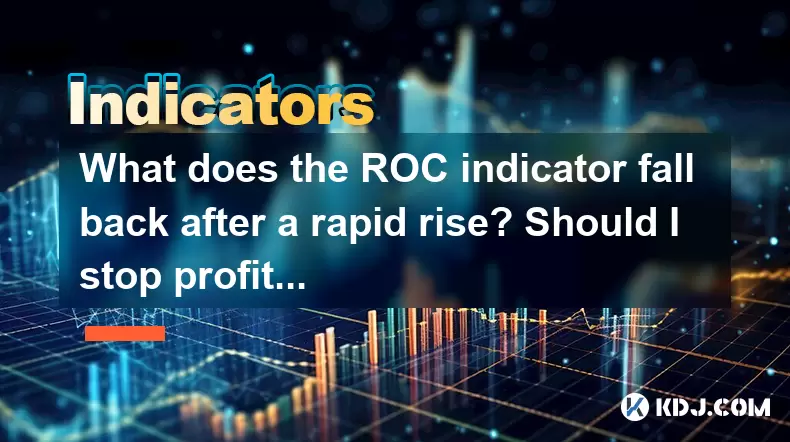-
 bitcoin
bitcoin $87959.907984 USD
1.34% -
 ethereum
ethereum $2920.497338 USD
3.04% -
 tether
tether $0.999775 USD
0.00% -
 xrp
xrp $2.237324 USD
8.12% -
 bnb
bnb $860.243768 USD
0.90% -
 solana
solana $138.089498 USD
5.43% -
 usd-coin
usd-coin $0.999807 USD
0.01% -
 tron
tron $0.272801 USD
-1.53% -
 dogecoin
dogecoin $0.150904 USD
2.96% -
 cardano
cardano $0.421635 USD
1.97% -
 hyperliquid
hyperliquid $32.152445 USD
2.23% -
 bitcoin-cash
bitcoin-cash $533.301069 USD
-1.94% -
 chainlink
chainlink $12.953417 USD
2.68% -
 unus-sed-leo
unus-sed-leo $9.535951 USD
0.73% -
 zcash
zcash $521.483386 USD
-2.87%
What does the ROC indicator fall back after a rapid rise? Should I stop profit in time?
A falling ROC after a rapid rise signals weakening momentum, often due to profit-taking or market saturation in volatile crypto markets.
Jun 17, 2025 at 02:50 am

Understanding the ROC Indicator in Cryptocurrency Trading
The Rate of Change (ROC) indicator is a momentum oscillator used by traders to identify the speed at which prices are changing in the cryptocurrency market. It measures the percentage change in price over a specified time period, typically 12 or 14 periods. When the ROC rises rapidly, it indicates strong upward momentum, often associated with aggressive buying pressure.
In the context of digital assets like Bitcoin or Ethereum, rapid price surges can cause the ROC to spike sharply. However, when this happens, many traders wonder: what does it mean when the ROC indicator falls back after a rapid rise?
Key Takeaway: A falling ROC after a sharp increase suggests that the momentum behind the price movement is weakening.
What Causes the ROC to Fall After a Rapid Rise?
Several factors contribute to the drop in the ROC value after a steep ascent:
- Profit-taking behavior: As prices climb quickly, early buyers may begin selling to lock in profits. This leads to a reduction in upward momentum.
- Market saturation: A sudden surge may attract too much attention, leading to short-term exhaustion of buyers.
- Overbought conditions: High ROC values often signal overbought territory, where the asset might be due for a pullback or consolidation phase.
These dynamics are especially visible in highly volatile crypto markets where sentiment and macro news play critical roles.
Important Note: A declining ROC doesn't always mean a reversal is imminent, but it signals caution.
Interpreting ROC Divergence in Crypto Charts
One of the most powerful ways to use the ROC indicator is through divergence analysis. For example:
- If the price continues to make higher highs while the ROC makes lower highs, this is considered bearish divergence, suggesting weakening momentum.
- Conversely, if the price makes lower lows but the ROC makes higher lows, this is bullish divergence, indicating potential strength ahead.
This kind of divergence becomes particularly meaningful after a rapid price move followed by a sudden ROC pullback.
Example: In late 2023, Ethereum's price surged sharply, pushing the ROC to extreme levels. Shortly after, the ROC began to decline even as the price tried to hold its gains—this was a sign of bearish divergence.
Should You Stop Profit When the ROC Falls After a Sharp Rise?
Deciding whether to take profit depends on several variables:
- Position size and risk tolerance: Larger positions may warrant partial profit-taking when signs of momentum fading appear.
- Timeframe being traded: Short-term traders might act more decisively than long-term investors.
- Support and resistance levels: Even if the ROC declines, strong technical support might justify holding.
It’s essential not to rely solely on the ROC. Combine it with other tools like moving averages, volume analysis, and chart patterns for confirmation.
Caution: Acting impulsively based only on a dropping ROC can lead to missed opportunities or premature exits.
How to Use ROC Alongside Other Indicators Effectively
To enhance your trading decisions, consider integrating the ROC with these complementary tools:
- Volume indicators: A drop in ROC accompanied by decreasing volume often reinforces the idea of weakening momentum.
- Bollinger Bands: Sudden spikes outside the bands followed by ROC drops can indicate overextended moves.
- RSI or MACD: These help confirm whether the market is overbought or showing signs of trend reversal.
By cross-referencing signals, you can avoid false alarms and make more informed decisions about when to exit trades.
Strategy Tip: Use multiple timeframes to analyze ROC behavior—higher timeframe trends may override short-term momentum shifts.
Frequently Asked Questions
Q1: Can the ROC indicator alone predict a market reversal?No, the ROC should never be used in isolation. While it provides insights into momentum changes, it lacks directional bias and needs confirmation from other tools like RSI, MACD, or candlestick patterns.
Q2: Is a rising ROC always bullish?Not necessarily. A rising ROC during a downtrend may reflect a short-term bounce rather than a sustainable uptrend. Context matters—always assess the broader trend and support/resistance levels.
Q3: How do I adjust ROC settings for different cryptocurrencies?Most platforms default to 12 or 14 periods. More volatile altcoins may benefit from shorter settings (e.g., 9), while major coins like BTC can use standard periods. Test various configurations using historical data before live trading.
Q4: What is the difference between ROC and RSI?While both are momentum oscillators, ROC focuses on price change rate, whereas RSI measures overbought/oversold conditions based on closing prices. They complement each other well in confirming trade setups.
Disclaimer:info@kdj.com
The information provided is not trading advice. kdj.com does not assume any responsibility for any investments made based on the information provided in this article. Cryptocurrencies are highly volatile and it is highly recommended that you invest with caution after thorough research!
If you believe that the content used on this website infringes your copyright, please contact us immediately (info@kdj.com) and we will delete it promptly.
- GeeFi Unleashes Game-Changing Staking with Up to 55% High-Yield APR for GEE Holders
- 2025-12-21 09:35:02
- Fiji's Currency Gets a Fresh Look: New Polymer Designs and Enhanced Circulation
- 2025-12-21 06:55:01
- Cathie Wood's Ark Invest Adjusts Tesla Investment, Eyes Crypto Opportunities
- 2025-12-21 06:45:02
- Navigating the New Frontier: Crypto Tax Bill, Stablecoins, and De Minimis Rules Take Center Stage
- 2025-12-21 03:35:01
- COIN's Compass: Coinbase Stock Market Performance Charting New Territories Amidst Evolving Crypto Landscape
- 2025-12-20 12:45:01
- GeeFi Rockets Towards 100x Returns, While Ripple Makes Strategic Stablecoin Moves
- 2025-12-20 06:15:02
Related knowledge

How to Combine Japanese Candlesticks with Western Chart Patterns (like Head and Shoulders)?
Dec 04,2025 at 02:40pm
Understanding Japanese Candlesticks in Modern Trading1. Japanese candlesticks offer a visual representation of price movement within a specific timefr...

A Deep Dive into the Three Outside Up/Down Patterns for Crypto Traders.
Dec 17,2025 at 07:39am
Understanding the Three Outside Up Pattern in Crypto Markets1. The Three Outside Up pattern is a bullish reversal formation that typically appears at ...

Can a Gravestone Doji at a Key Resistance Level Signal a Perfect Short Entry?
Nov 28,2025 at 09:40pm
Understanding the Gravestone Doji in Technical Analysis1. The Gravestone Doji is a candlestick pattern characterized by an opening and closing price t...

What Do Overlapping Candlesticks Reveal About Support and Resistance in Crypto?
Dec 13,2025 at 08:39am
Understanding Overlapping Candlesticks in Crypto Charts1. Overlapping candlesticks occur when multiple price candles on a chart share similar high or ...

How to Tell if a Crypto Breakout is Real Using Candlestick and Volume Analysis?
Nov 28,2025 at 05:39am
Understanding the Anatomy of a Genuine Crypto Breakout1. A true breakout in the cryptocurrency market is not defined solely by price surpassing a resi...

The Definitive Guide to Entry and Exit Points Using Crypto Candlestick Patterns.
Nov 29,2025 at 06:59am
Understanding Bullish Reversal Patterns1. The hammer candlestick pattern typically appears at the end of a downtrend and signals a potential reversal....

How to Combine Japanese Candlesticks with Western Chart Patterns (like Head and Shoulders)?
Dec 04,2025 at 02:40pm
Understanding Japanese Candlesticks in Modern Trading1. Japanese candlesticks offer a visual representation of price movement within a specific timefr...

A Deep Dive into the Three Outside Up/Down Patterns for Crypto Traders.
Dec 17,2025 at 07:39am
Understanding the Three Outside Up Pattern in Crypto Markets1. The Three Outside Up pattern is a bullish reversal formation that typically appears at ...

Can a Gravestone Doji at a Key Resistance Level Signal a Perfect Short Entry?
Nov 28,2025 at 09:40pm
Understanding the Gravestone Doji in Technical Analysis1. The Gravestone Doji is a candlestick pattern characterized by an opening and closing price t...

What Do Overlapping Candlesticks Reveal About Support and Resistance in Crypto?
Dec 13,2025 at 08:39am
Understanding Overlapping Candlesticks in Crypto Charts1. Overlapping candlesticks occur when multiple price candles on a chart share similar high or ...

How to Tell if a Crypto Breakout is Real Using Candlestick and Volume Analysis?
Nov 28,2025 at 05:39am
Understanding the Anatomy of a Genuine Crypto Breakout1. A true breakout in the cryptocurrency market is not defined solely by price surpassing a resi...

The Definitive Guide to Entry and Exit Points Using Crypto Candlestick Patterns.
Nov 29,2025 at 06:59am
Understanding Bullish Reversal Patterns1. The hammer candlestick pattern typically appears at the end of a downtrend and signals a potential reversal....
See all articles









































































